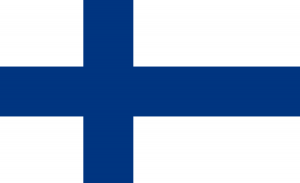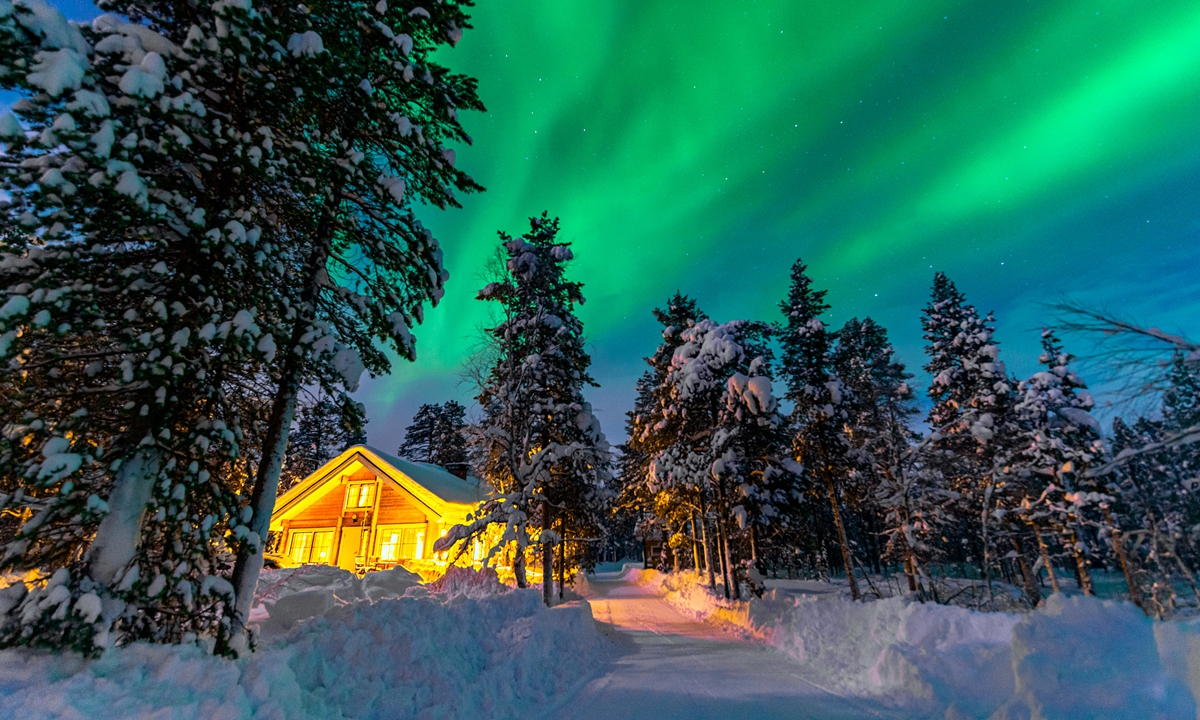Language/Finnish/Culture/Finland-Timeline
Interesting Facts about Finland[edit | edit source]
- Country : FINLAND🇫🇮
- Capital: Helsinki
- Continent: Europe
- Currency: Euro
- Official Language: Finnish, Swedish
1. Finland is the first country in the world to make Internet access a legal right.
2. Sun never sets off in Finland during summertime for straight 73 days.
3. The educational system of Finland is ranked among the best in the world.
4. There are 187,888 lakes in Finland.
5. Päijänne Water Tunnel is the second longest tunnel in the world.
6. Finland has a High Number of Heavy Metal Bands.
7. The Aurora Borealis (Northern Lights) are seen in every season in Lapland
8. The first cell phones were made by a Finnish company called Nokia.
9. Midnight Sun Film Festival is one of the longest-running film festivals in the world.
10. The Snow Castle of Kemi, Finland, is the biggest snow fort in the world.
11. Kakslauttanen is home to the original glass igloos
12. There are 2.2 million Saunas. It is a wood-fired or electrically heated room used for relaxation and cleansing.
13. Finland is the perfect place for riding a husky-driven sleigh through the frozen landscapes.
14. The northernmost region in Finland, is known as Santa Clause’s home.
15. Finland is popular for - Salmiakki candy.
16. Finland holds world championships for mosquito catching.
Source[edit source]
- Content Research - Ms Harshali Dhatavkar
➡ To LEARN & SHARE interesting experiences: Join the WhatsApp group
Finland Timeline[edit | edit source]
| Date | Event |
|---|---|
| 12,500 BC AD | First traces (stone tools) attesting that Finland is inhabited. Disappearance of the population during the glaciation. |
| 900 BC | Territory again accessible following the melting of the ice with a number of lakes and prolific forests for hunting and fishing. |
| 3000 BC | Traces of a new culture (comb ceramics), perhaps the beginning of a proto-Finnish language. |
| 1st century BC. J. C. | The territory begins to be occupied by the Finns. The Roman historian Tacitus speaks of the "fenni", surely the first nomadic Sami. |
| 400 apr. AD | The Åland Islands are populated by Swedes. |
| 1157 | First Swedish crusade, progressive colonization of the southwest of the Finnish peninsula. Christianization of the country. |
| 1200-1300 | Swedish settlers settle in coastal regions. Finland will then be under Swedish domination for six centuries. |
| 1323 | The war between Sweden and Novgorod ends with the treaty of Pähkinäsaari also known as Nöteborg which delimits the borders; Sweden obtains Finland proper (Suomi), Tavastie and part of Karelia. |
| 1362 | Participation of the Finns in the election of the King of Sweden. |
| 1397 | Union of Kalmar: reunification of the Scandinavian kingdoms of Norway, Denmark and Sweden and therefore of Finland united under a single monarch, namely Marguerite I of Denmark. |
| 1523 | End of the union following the election of King Gustave Vasa of Sweden. |
| 1527 | Lutheran reform. |
| 1543 | Mikael Agricola produces the first book in the Finnish language (a volume of Finnish grammar). |
| 1550 | Gustav I Vasa founds Helsinki. |
| 1595 | The peace of Täyssinä, following a Russo-Swedish war, fixes the eastern borders of Finland. |
| 1618-1648 | Thirty Years' War. |
| 1640 | Queen Catherine of Sweden establishes the first Finnish university in Turku. |
| 1714-1721 | Period of the Great Anger when the Russian armies occupy and ravage the country. |
| 1721 | The Treaty of Nystad amputates from and Ingria. |
| 1741-1743 | Period of the Little Wrath with a new Russian invasion which ends with the Treaty of Abo and the cessation of part of Savonia from the enemy. |
| 1747 | Sweden begins construction of the Sveaborg (Suomenlinna) fortress opposite Helsinki. |
| 1808 | Hamina Peace Treaty; Finland, ceded by Sweden to Russia, becomes Grand Duchy of the Russian Empire, endowed with wide autonomy. |
| 1812 | Helsinki replaces Turku as the capital. |
| 1828 | The University of Turku is transferred to Helsinki. |
| 1835 | Publication of the Kalevala written by Elias Lönnrot, Finnish national epic based on Finnish mythology transmitted orally (popular poems collected from the populatin). major work symbolic of Finnish national identity. |
| 1860 | The Finnish mark becomes the official currency of Finland. |
| 1863 | Finnish becomes an official language just like Swedish. |
| 1898-1904 | Dictatorial government of General Nikolai Ivanovich Bobrikov (assassinated in 1904). |
| 1900 | The Finnish pavilion receives admiration at the Universal Exhibition in Paris. It is the golden age of Finnish art with painters such as Edelfelt, Gallèn-Kallela, Järnefelt, Halonen and the composer Sibelius. |
| 1906 | Finland establishes its own national parliament elected by universal suffrage; Finns become the first women in the world to obtain full recognition of their civic rights (the right to vote and the right to be elected). |
| 1917 | October Revolution in Russia, Finland proclaims its independence. December 6, 1917 marks the beginning of the National Day celebrated every year. |
| 1918 | Four-month civil war between the pro-Soviet Reds and the White Civil Guard of Carl Gustaf Mannerheim. He won and Carl Gustaf Mannerheim was elected regent of Finland. |
| 1919 | The current Constitution is adopted. |
| 1920 | Admission of Finland into the League of Nations. |
| 1921 | The League of Nations recognizes the sovereignty of Finland over the Åland archipelago. |
| 1924 | Paavo Nurmi wins four gold medals at the Olympic Games in Paris. |
| 1939-1940 | Winter War against the Soviet Union, peace treaty of Moscow and Karelia is annexed by the USSR. |
| 1941-1944 | Finland makes an alliance with Germany in the Continuation War against the USSR. The armistice was concluded in Moscow in 1944. |
| 1948 | Pact of friendship, cooperation and peaceful coexistence between Finland and the USSR. |
| 1952 | Olympic Games in Helsinki. End of the payment of the war tribute of 300 million dollars in reparations to the USSR imposed during the Treaty of Paris in 1947. |
| 1955 | Admission to the UN. |
| 1956 | Joined the Nordic Council. Beginning of the long presidency of Urho Kaleva Kekkonen who pursues a policy of cooperation with the Nordic countries and friendship with the USSR. |
| 1975 | Conference on Security and Cooperation in Europe (C.S.C.E.) in Helsinki. 1981 |
| 1989 | Finland becomes a member of the Council of Europe. |
| 1991 | Finnish student Linus Torvalds develops the "Linux" operating system. |
| 1991-1993 | Serious economic and banking system crisis following the explosion of credit and the real estate bubble. Finland is becoming an example of financial crisis resolution by finding balance in just 3 years: the GDP fell by 11% and the unemployment rate fell from 3% to 18%. |
| 1994 | First presidential election by direct universal suffrage. Martti Ahtisaari, SPD candidate (Social Democratic Party), wins ahead of Elizabeth Queen, representative of the Swedish minority. He remained at the head of the country until 2000. |
| 1994 | Referendum on Finland's entry into the European Union (EU). Voters vote "yes" at 57%. |
| 1995 | Finland becomes a member of the European Union. |
| 1999 | Entry into Economic and Monetary Union; Presidency of the Council of Europe. |
| 2000 | New Constitution which increases the parliamentary provisions of the Finnish regime. |
| 2000 | Election as President of the Republic of Tarja Halonen with 51.6% of the vote. For the first time, a woman rules Finland. |
| 2002 | The new European currency, the euro, becomes the official Finnish currency. |
| 2003 | Legislative elections. The two big winners of the ballot, the Center Party and the left-oriented SPD, form a center-left coalition. Matti Vanhanen is appointed Prime Minister. |
| 2004 | The municipal elections confirm the preponderance on the Finnish political landscape of the SPD. The Center Party, of which the Prime Minister is a member, on the other hand emerges from the poll weakened. |
| 2006 | Re-election of Tarja Halonen as President against the conservative Sauli Niinitö. |
| 2006 | Finland holds the Presidency of the Council of the European Union for the second time for six months. During her mandate, she has to face several challenges including the war in Lebanon, or the enlargement of the EU. |
| 2007 | General elections: the Center Party remains the leading Finnish party against the Conservatives (only one seat away). Matti Vanhanen retains his post as Head of Government. The Conservatives have made a lot of progress, however. |
| 2007-2008 | Two school shootings one year apart call into question the national arms sales policy. Finland is indeed the third country in the ranking of the number of weapons per capita, behind the United States and Yemen. In this country of five million inhabitants, including many hunters, there are around 2 million weapons. |
| 2008 | Finland takes over the presidency of the OSCE (Organization for Security and Co-operation in Europe) for one year. |
| 2008 | Finland agrees to be part of the FRO (NATO Rapid Reaction Force), breaking out of its tradition as a non-aligned country since the end of World War II. |
| 2008 | The Nobel Peace Prize is awarded to former President Martti Ahtisaari for his contribution to the maintenance of peace in the world. |
| 2011 | Legislative elections. On April 17, the populist "True Finns" party led by ultra-conservative, nationalist, anti-European and anti-immigration Timo Soini won 34 seats in Parliament. Historical score ... |
| 2012 | Presidential elections in February. Sauli Niinistö wins after a campaign marked by the country's place in the European Union, with 62.60% of the vote. It is the great return of the right, absent from power since 1956; his term of office runs until 2018. The “True Finns” do not make it to the second round with a score of 9.4%. |
| 2013 | The Finnish giant Nokia, until then a national symbol of economic and technological success, has its mobile telephony branch bought out by Microsoft. Nokia, which then represented 4% of GDP and 25% of exports, led to national bankruptcy. |
| 2015 | Legislative elections. On April 19, the Center Party won the elections with 49 seats. New Prime Minister Juha Sipilä announces the creation of a coalition government with the populist True Finns Party and the National Coalition Party. |
| 2017 | Centenary of the independence of Finland. |
| 2018 | Overwhelming re-election of right-wing President Sauli Niinistö (62.65%) as an independent candidate, in particular thanks to his strategy towards Russia. Its major goal was to place the country under the protection of the nuclear shield without hurting its Russian neighbor. Reconciliation assumed therefore with the West. |
Source[edit | edit source]
- https://fr.wikipedia.org/
- https://www.petitfute.com/p23-finlande/guide-touristique/c6235-histoire.html
World Timelines[edit source]


